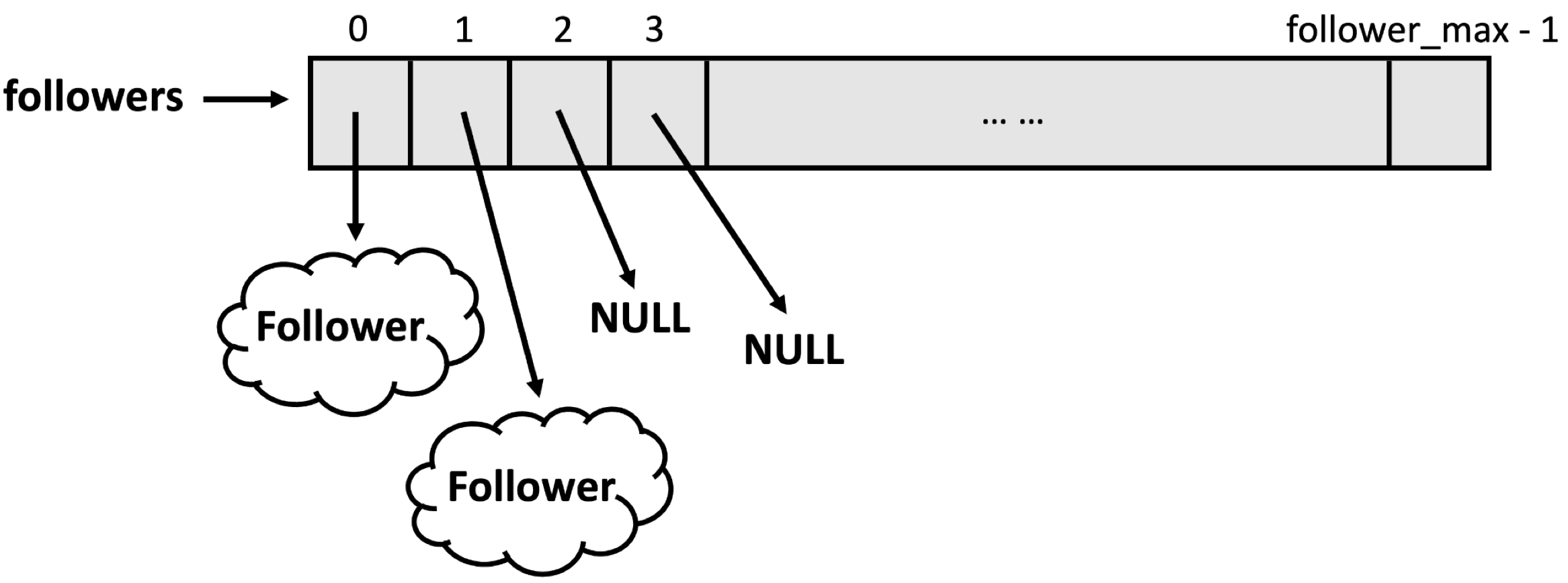Exercises
6.1. Exercises#
Many of these exercises are taken from past exams of ECE 244 Programming Fundamentals courses at University of Toronto. The solutions are provided in the answer boxes.
Headings in this page classify the exercises into different categories: [Easy], [Intermediate], and [Challenging]. I suggest you start by easy exercises and work your way up to the challenging ones.
Question 3 in Fall 2022 Midterm Exam [Easy]
Consider the following C++ function:
void AvadaKedavra(int n) {
int size = n + 1;
int* q = NULL;
for (int i = 0; i < 3; ++i) {
q = new int[size];
}
}
If somewhere in your main function you call AvadaKedavra(1). Based on the memory layout discussed during the lecture, answer this question: from the time this function starts to execute to the time right before it returns, how many bytes are newly allocated on the stack and the heap, respectively?
You may assume:
all variables are put in the main memory.
an
inttakes 4 byteswe have a 32-bit machine
Answer
Stack
n: 4 bytes
size: 4 bytes
q: 4 bytes
i: 4 bytes
Total: 16 bytes
Heap
n is 1, size is 2
The loop iterates 3 times, each time it allocates 2 integers.
Total is 3 * 2 * 4 bytes = 24 bytes.
Question 9 in Fall 2021 Midterm Exam [Intermediate]
Consider the code shown below. You can assume it compiles with no errors and runs.
#include <iostream>
using namespace std;
int a = 0;
int* b = &a;
int** c = &b;
int* foo(int** d) {
(**d)++;
b = *d;
int* e = new int;
*e = 10;
return e;
}
int main() {
int* g = nullptr;
int* f = new int;
*f = 5;
a++;
// Point 1
g = foo(&f);
a++;
(*g)++;
// Point 2
return 0;
}
In the table below, give the values of the variables indicated in the table columns when program execution reaches each of the two points, Point 1 and Point 2. If a value cannot be obtained due to dereferencing a nullptr pointer, write nullptr (but assume the program does not stop).
|
|
|
|
|
|
|---|---|---|---|---|---|
Point 1 |
|||||
Point 2 |
Answer
|
|
|
|
|
|
|---|---|---|---|---|---|
Point 1 |
1 |
1 |
1 |
|
5 |
Point 2 |
2 |
6 |
6 |
11 |
6 |
Question 10 in Fall 2022 Midterm Exam [Challenging]
A Vtuber is an online entertainer who posts videos on Vtube. A Vtuber will have followers on Vtube. As a programmer from Vtube, you are asked to implement a class for Vtuber. The class definition and description are described below.
#include <string>
using namespace std;
class Follower {
private:
string name;
int age;
public:
Follower(const string& _name, int _age) {
name = name_;
age = age_;
}
string get_name() const { return name; }
int get_age() const { return age; }
};
class Vtuber {
private:
// Vtuber Name
string name;
// Follower array with a variable size, each element should be a dynamically
// allocated object of class Follower.
Follower** followers;
// The size of follower array.
int follower_max;
// Number of followers
int follower_num;
public:
Vtuber(const string& _name);
~Vtuber();
void insert_follower(const string& follower_name, int follower_age);
void remove_follower(const string& follower_name);
};
Specifically, Vtuber’s followers member variable is an array of pointers, each pointer pointing to a Follower object. The following graph illustrates it.

Implement the constructor for
Vtuber. Vtubernameshould be initialized by_name, andfollower_maxshould be initialized to 2. In addition, you should allocate an array calledfollowersusingnew, with an initial size of 2 (the value offollower_max). Every element in this array should be a pointer to an object of classFollowerand initialize all these pointers toNULL.Vtuber::Vtuber (const string& _name) {
Answer
Vtuber::Vtuber(const string& _name) { name = _name; follower_max = 2; follower_num = 0; followers = new Follower*[follower_max]; for (int i = 0; i < follower_max; i++) { followers[i] = NULL; } }
Every Vtuber in
Vtubecan get new followers or lose their current followers. This is implemented by two methods:insert_followerandremove_follower. Now you are asked to implement these two methods:For insert_follower, a follower name and follower age are given. You need to create a dynamically allocated object of
Followerand insert it into the followers array (in the first available location), usingnewoperator. If the array is full, you should doublefollower_max, allocate a new follower array, and move all the data into thisnewarray, and insert thenewfollower. Write the code below.void Vtuber::insert_follower(const string& follower_name, int follower_age) {
Answer
void Vtuber::insert_follower(const string& follower_name, int follower_age) { follower_num++; for (int i = 0; i < follower_max; i++) { if (followers[i] == NULL) { followers[i] = new Follower(follower_name, follower_age); return; } } Follower** new_followers = new Follower*[2 * follower_max]; for (int i = 0; i < follower_max; i++) { new_followers[i] = followers[i]; new_followers[i + follower_max] = NULL; } new_followers[follower_max] = new Follower(follower_name, follower_age); delete[] followers; followers = new_followers; follower_max *= 2; return; }
For
remove_follower, a follower name is given. If there is any follower in the array matching the name, you should remove it and free its memory usingdelete. You can assume the follower names are all unique.void Vtuber::remove_follower(const string& follower_name) {
Answer
void Vtuber::remove_follower(const string& follower_name) { for (int i = 0; i < follower_max; i++) { if (followers[i] == NULL) // 3 marks on skipping NULL members continue; if (followers[i]->get_name() == follower_name) { // 1 mark follower_num--; // 1 mark delete followers[i]; // 2 mark followers[i] = NULL; // 1 mark break; } } return; }
Implement the destructor for the
Vtuberclass. You should free all the dynamically allocated objects usingdelete. Remember to be consistent with your previous implementation, as the entire program should not trigger any segmentation fault.Vtuber::~Vtuber() {
Answer
Vtuber::~Vtuber() { for (int i = 0; i < follower_max; i++) { delete followers[i]; // delete NULL is safe; } delete[] followers; }
